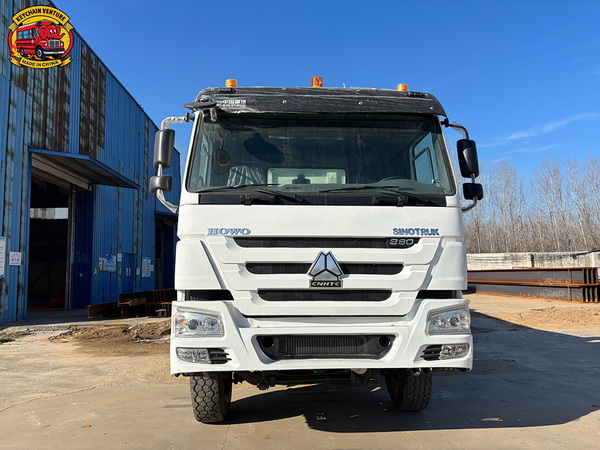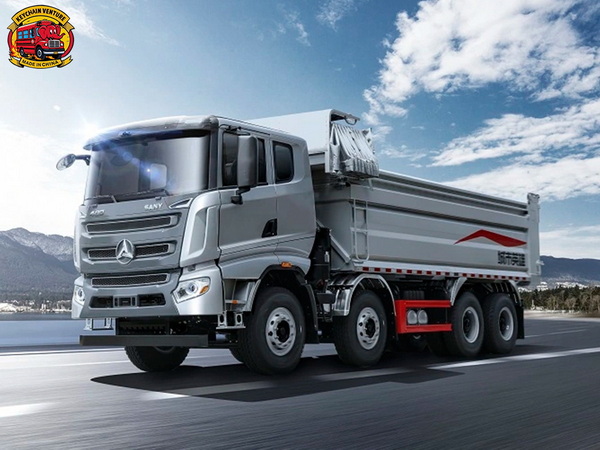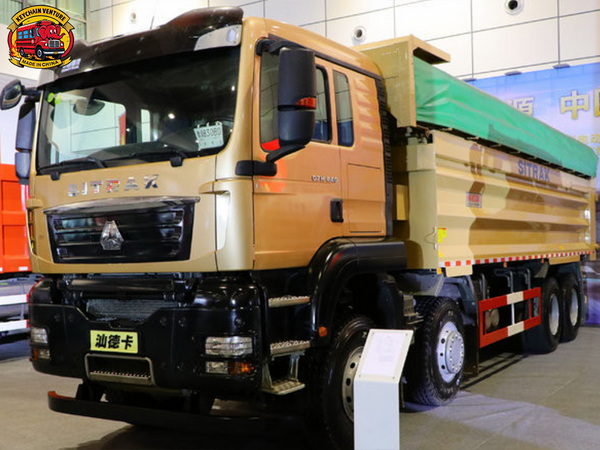Views: 222 Author: Amanda Publish Time: 2025-10-27 Origin: Site








Content Menu
>> Types of Dump Trucks and Their Roles
● Factors Determining Dump Truck Carrying Capacity
>> Vehicle Size, Structure, and Engineering
>> Material Density and Volume Calculation
>> Road Regulations and Legal Load Limits
>> Operational Environment and Use Case
● KeyChain Venture Co., Ltd.: Leading Dump Truck Solutions
>> What Sets KeyChain Venture Apart?
● Dump Truck Applications in Modern Industry
>> Construction
>> Urban and Infrastructure Projects
>> Specialized Industrial Uses
● How to Calculate and Optimize Dump Truck Use
>> Step-by-Step Payload Calculation
>> Enhancing Dump Truck Productivity
● Safety and Maintenance Best Practices
● Technological Advancements in Dump Truck Design
● Selecting the Right Dump Truck
● Industry Trends and the Future of Dump Trucks
● FAQ
>> 1. How many tons can a standard dump truck carry?
>> 2. What is the main limitation on dump truck capacity?
>> 3. What is the largest dump truck capacity in the market?
>> 4. How do I determine the safe load for my dump truck?
>> 5. What maintenance is crucial for dump trucks?
Dump trucks are essential vehicles across a wide range of industries, from construction and mining to transportation and urban infrastructure projects. Understanding the carrying capacity of dump trucks is crucial for maximizing operational efficiency, ensuring compliance with regulations, and achieving success in heavy-duty projects. Whether you are a project manager, fleet operator, or decision-maker seeking reliable solutions, knowing how many tons a Dump Truck can carry is fundamental to effective planning and productivity.

A dump truck is a specialized commercial vehicle engineered to transport and unload loose materials, such as sand, gravel, demolition debris, coal, and aggregates. The defining feature of a Dump Truck is its hydraulic bed, which tilts to allow the contents to be quickly and easily discharged at the destination. As construction technology advances, dump trucks have evolved into several types, each designed with specific performance criteria and operational demands in mind.
- Standard dump trucks, commonly seen on city streets and construction sites, offer moderate capacity and exceptional maneuverability.
- Articulated dump trucks, built for off-road operations, provide high stability and are indispensable in mining and large-scale earth-moving projects.
- Transfer dump trucks consist of a standard dump truck pulling a separate trailer, ideal for maximizing load without breaching highway weight restrictions.
- Super dump trucks feature additional lift axles for superior payloads on roads, balancing capacity with legal compliance.
- Side dump trucks can unload materials to the side, reducing operational hazards in tight or sensitive workspaces.
Each type of dump truck serves a unique role and directly influences the range of material tonnage it can transport.
The core determinant of a dump truck's capacity is its physical size and engineered weight limit. Small dump trucks are suitable for municipal or landscaping tasks and typically accommodate 5 to 10 tons. In contrast, standard models range from 10 to 20 tons, while large articulated and off-highway trucks, tailored for mine sites and aggregate yards, can carry anywhere from 50 to over 400 tons in a single load.
Dump truck capacity varies depending on the density of the load. For example, wet sand and gravel are significantly heavier per cubic meter than mulch or topsoil. Operators must be mindful to match not only the truck's volumetric limit but also the weight of the material to ensure loads remain within safe and legal limits.
To estimate a dump truck's maximum haul:
Volume (m3)=Length (m)×Width (m)×Height (m)
Payload (tons)=Volume (m3)×Material Density (ton/m3)
Always refer to manufacturer guidelines for the official rated payload.
Legal restrictions also govern how much a dump truck can carry, particularly when traveling on public roads. Jurisdictions in China and around the world enforce axle load limits and gross vehicle weights to protect infrastructure and enhance road safety. For instance, typical highway dump trucks are often capped at 25 to 40 tons, regardless of their technical capacity.
Off-road tasks such as mining and large-scale earthworks enable the use of colossal dump trucks that are impractical or illegal on public highways, such as the BelAZ 75710, capable of handling over 400 tons per trip. Conversely, urban dump trucks require enhanced agility and safety features suited for crowded, confined spaces.
As a premier supplier in China, KeyChain Venture Co., Ltd. stands at the forefront of commercial vehicle innovation, offering a robust portfolio of dump trucks engineered for high performance and reliability. Clients around the world trust our expertise to deliver tailored solutions that balance maximum payload, durability, safety, and compliance with international standards.
- State-of-the-art chassis and customizable dump bodies to fit diverse applications.
- Advanced hydraulic lifting mechanisms for efficient unloading.
- Industry-leading support, including consultation, training, and parts service.
- Commitment to environmental sustainability and regulatory conformity.
We combine technological advancement with practical, field-tested engineering to provide heavy vehicles that meet the highest expectations.
On construction sites, dump trucks are indispensable for moving excavation spoil, delivering aggregate for concrete, and disposing of demolition waste. Timely transport and precise unloading are vital for workflow efficiency and safety.
Mining operations require some of the world's largest dump trucks, handling hundreds of tons per load over rough, uneven terrain. Their performance, durability, and capacity are directly linked to the profitability and safety of mining operations.
Smaller, road-friendly dump trucks serve municipalities in tasks such as paving, snow removal, and landscaping. Their maneuverability and flexible payload adaptation make them ideal for urban projects.
Dump trucks also play a role in recycling, agriculture, and disaster relief, supporting responses to emergencies by swiftly clearing debris or delivering critical materials.

1. Measure Internal Dimensions: Record the dump bed's internal length, width, and height in meters.
2. Calculate Volume: Multiply the three dimensions to get the bed's volume in cubic meters.
3. Determine Load Type: Identify the density of the material to be hauled (for example, gravel ≈ 1.8 t/m³).
4. Estimate Total Weight: Multiply dump bed volume by material density to get the payload in tons.
5. Check Regulatory Limits: Ensure the calculated payload does not exceed legal or manufacturer limits.
- Select trucks with optimal size and axle configurations for specific routes and tasks.
- Plan material types for each trip, prioritizing lighter loads on weaker surfaces.
- Utilize telematics and route planning software to maximize efficiency while reducing fuel consumption and emissions.
Operating a dump truck safely goes beyond simply respecting load limits. Safety protocols and regular maintenance are essential to prevent accidents, reduce downtime, and protect both operators and cargo.
- Always verify tire condition and pressure before each journey.
- Inspect hydraulic lifts for leaks or abnormal pressure drops.
- Never exceed the manufacturer's recommended payload.
- Secure the load to prevent spillage during transit and unloading.
- Stay vigilant in high-traffic areas and signal clearly during maneuvers.
- Conduct routine checks for wear and damage on moving parts.
- Lubricate critical joints and hydraulic mechanisms according to the maintenance schedule.
- Replace worn tires, damaged bed linings, and faulty hydraulic components promptly.
- Document every maintenance session for compliance and insurance records.
Prioritizing these practices extends dump truck service life and minimizes the risk of costly breakdowns.
Manufacturers like KeyChain Venture Co., Ltd. are constantly innovating to keep pace with evolving industry demands. Modern dump trucks now incorporate:
- On-board weighing systems for real-time payload monitoring
- Fuel-efficient engines meeting the latest emissions standards
- GPS tracking and fleet telematics for logistics management
- Remote diagnostics and predictive maintenance capabilities
- Enhanced safety systems such as electronic stability control and collision avoidance
These advancements help operators optimize performance, control costs, and comply with sustainability goals.
Choosing the most suitable dump truck involves more than comparing stated capacities. Consider:
- Type of material: Heavier or more abrasive materials may necessitate upgrades in bed lining and chassis reinforcement.
- Route and terrain: Urban areas demand compact size and turning agility, while off-road tasks benefit from articulation and higher ground clearance.
- Legal and insurance constraints: Regulatory compliance is paramount for both highway and jobsite operations.
- Supplier reputation: Partnering with an established manufacturer ensures long-term service, parts availability, and expert advice.
KeyChain Venture Co., Ltd. partners with every client to match equipment to operational requirements, ensuring a cost-effective, future-ready fleet.
The dump truck industry continues to evolve with trends such as electrification, hydrogen power, and automation. Future-ready dump trucks will emphasize:
- Lower environmental impact with new-generation alternative fuel engines
- Intelligent load optimization through data analytics
- Greater use of composite materials to reduce vehicle weight while increasing payload
- Driver-assist features and semi-autonomous technologies for safety and efficiency
As cities and industries worldwide focus on sustainability and smart logistics, dump trucks will remain pivotal to progress.
In summary, the carrying capacity of dump trucks spans a broad spectrum—from compact, street-legal models built for city use to massive, off-highway giants dominating mining and infrastructure megaprojects. By understanding the unique factors that affect how many tons a dump truck can carry, operators, buyers, and project managers can make informed, productive, and safe decisions. KeyChain Venture Co., Ltd. delivers tailored solutions, combining advanced engineering with deep industry insight to meet your most demanding hauling requirements. For reliable, efficient, and innovative dump truck solutions, choose the expertise and dedication that have made us an industry leader at home and abroad.

A standard dump truck typically carries 10 to 20 tons, depending on its size, build quality, and legal road limits.
Legal road weight limits, material density, and truck bed size all restrict the number of tons a dump truck can haul at once.
Ultra-class mining dump trucks such as the BelAZ 75710 can haul more than 400 tons in a single load.
Multiply the internal bed volume by the density of the material, then check the result against the truck's rated payload and local regulations.
Frequent inspection of tires, hydraulics, and dump bed components, along with regular lubrication and prompt repairs, is essential for safety and long vehicle life.